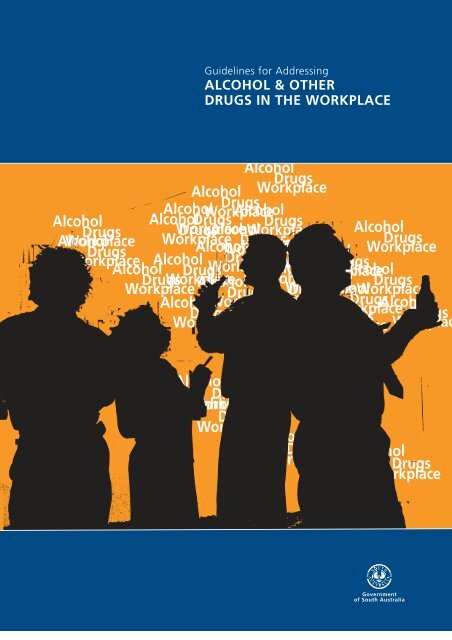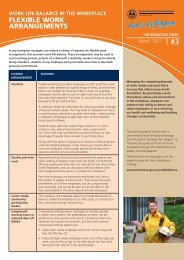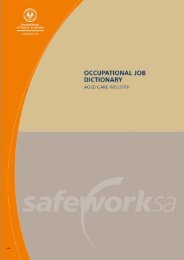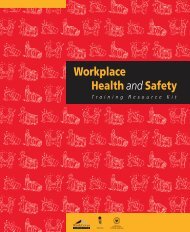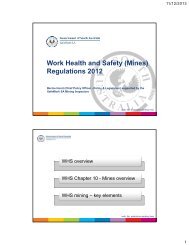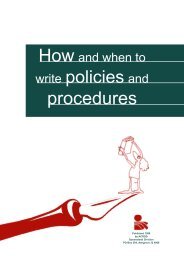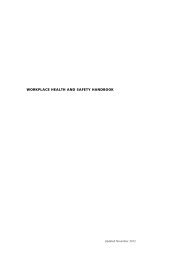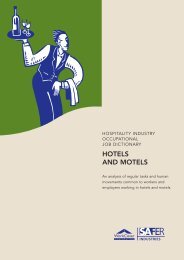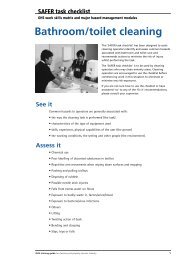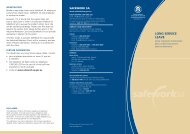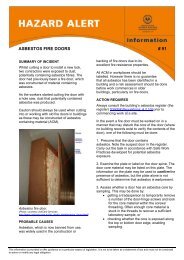Alcohol Drugs Workplace Alcohol Drugs Workplace - SafeWork SA ...
Alcohol Drugs Workplace Alcohol Drugs Workplace - SafeWork SA ...
Alcohol Drugs Workplace Alcohol Drugs Workplace - SafeWork SA ...
Create successful ePaper yourself
Turn your PDF publications into a flip-book with our unique Google optimized e-Paper software.
Guidelines for Addressing<br />
ALCOHOL & OTHER<br />
DRUGS IN THE WORKPLACE<br />
<strong>Alcohol</strong><br />
<strong>Drugs</strong><br />
<strong>Alcohol</strong> <strong>Workplace</strong><br />
<strong>Alcohol</strong><br />
<strong>Drugs</strong><br />
<strong>Alcohol</strong><br />
<strong>Workplace</strong> <strong>Alcohol</strong><br />
<strong>Drugs</strong> <strong>Drugs</strong><br />
<strong>Workplace</strong> <strong>Drugs</strong> <strong>Alcohol</strong> <strong>Workplace</strong><br />
<strong>Alcohol</strong> <strong>Workplace</strong><br />
<strong>Alcohol</strong><br />
<strong>Drugs</strong><br />
<strong>Workplace</strong><br />
<strong>Alcohol</strong><br />
<strong>Drugs</strong><br />
<strong>Workplace</strong> <strong>Alcohol</strong> <strong>Drugs</strong> <strong>Drugs</strong><br />
<strong>Alcohol</strong> <strong>Drugs</strong> <strong>Workplace</strong> <strong>Workplace</strong><br />
<strong>Drugs</strong> <strong>Workplace</strong><br />
<strong>Workplace</strong> <strong>Alcohol</strong><br />
<strong>Alcohol</strong><br />
<strong>Drugs</strong><br />
<strong>Alcohol</strong><br />
<strong>Workplace</strong><br />
<strong>Alcohol</strong> <strong>Drugs</strong><br />
<strong>Drugs</strong> <strong>Alcohol</strong> <strong>Workplace</strong><br />
<strong>Alcohol</strong> <strong>Workplace</strong> <strong>Drugs</strong><br />
<strong>Alcohol</strong><br />
<strong>Workplace</strong> <strong>Alcohol</strong><br />
<strong>Drugs</strong> <strong>Drugs</strong><br />
<strong>Drugs</strong> <strong>Workplace</strong> <strong>Drugs</strong> <strong>Alcohol</strong> <strong>Workplace</strong><br />
<strong>Alcohol</strong> <strong>Workplace</strong> <strong>Workplace</strong><br />
<strong>Alcohol</strong><br />
<strong>Drugs</strong><br />
<strong>Drugs</strong><br />
<strong>Workplace</strong><br />
<strong>Alcohol</strong><br />
<strong>Workplace</strong><br />
<strong>Drugs</strong> <strong>Drugs</strong><br />
<strong>Workplace</strong> Workplac<br />
<strong>Alcohol</strong><br />
<strong>Drugs</strong><br />
<strong>Workplace</strong> <strong>Alcohol</strong><br />
<strong>Alcohol</strong> <strong>Drugs</strong><br />
<strong>Drugs</strong> <strong>Workplace</strong><br />
<strong>Workplace</strong> <strong>Alcohol</strong><br />
<strong>Alcohol</strong><br />
<strong>Drugs</strong><br />
<strong>Workplace</strong><br />
<strong>Drugs</strong><br />
<strong>Alcohol</strong> <strong>Workplace</strong><br />
<strong>Drugs</strong><br />
<strong>Workplace</strong>
CONTENTS<br />
1 INTRODUCTION 2<br />
2 DUTIES OF EMPLOYERS AND EMPLOYEES 3<br />
2.1 Duty of care<br />
2.2 Obligations of employers (Sections 19 & 20 of the Occupational Health,<br />
3<br />
Safety and Welfare Act 1986)<br />
2.3 Obligations of employees (Section 21 of the Occupational Health, Safety<br />
3<br />
and Welfare Act 1986)<br />
2.4 Obligations of self-employed persons (Section 22 of the Occupational<br />
3<br />
Health, Safety and Welfare Act 1986) 3<br />
2.5 Duty in relation to third persons<br />
2.6 Duties of employers under the Occupational Health, Safety and Welfare<br />
4<br />
Regulations 1995 4<br />
2.7 Other legislation 4<br />
3 HAZARD IDENTIFICATION AND RISK ASSESSMENT 6<br />
4 CONTROL STRATEGIES 8<br />
4.1 Policy on alcohol and other drugs at the workplace 8<br />
4.1.1 Why develop a policy? 8<br />
4.1.2 How to develop a policy 9<br />
4.1.3 Key steps in policy development 9<br />
4.1.4 Content of policy 10<br />
4.1.5 Content of supporting procedures 10<br />
4.2 Education at the workplace 12<br />
4.3 Identifying persons impaired by alcohol or other drugs 12<br />
4.4 Safeguards for medication 15<br />
4.5 Employee Assistance Program (EAP) 16<br />
5 INFORMATION ON ALCOHOL AND OTHER DRUGS 17<br />
5.1 <strong>Alcohol</strong> 17<br />
5.2 Other drugs 17<br />
5.2.1 Cannabis 17<br />
5.2.2 Opiate analgesics 18<br />
5.2.3 Stimulants 18<br />
5.2.4 Volatile substances (solvents and inhalants) 19<br />
5.2.5 Medication 19<br />
6 FURTHER INFORMATION 21<br />
7 APPENDIX 22<br />
DISCLAIMER<br />
The information, opinions and advice contained in this booklet have been prepared with due care and are believed to be<br />
correct at the time of publication. The publishers expressly disclaim any liability whatsoever to any person who suffers any loss<br />
arising from the contents of, or errors in, or omissions from this publication. This booklet is not intended as a substitute for<br />
legal advice.<br />
These guidelines are reproduced courtesy of the Commission for Occupational Safety and Health, Western Australia<br />
(www.worksafe.wa.gov.au).
2<br />
1. INTRODUCTION<br />
A range of factors, both at the workplace and in our private lives, impact on our ability to<br />
work safely. These factors, as they relate to the workplace, must be dealt with through the<br />
normal procedures for dealing with health and safety issues at the workplace. <strong>Alcohol</strong> and<br />
other drugs may be a factor that affects a person’s ability to work safely.<br />
The use of alcohol and other drugs becomes an occupational health and safety issue if a<br />
person’s ability to exercise judgment, coordination, motor control, concentration and<br />
alertness is affected at the workplace, leading to an increased risk of injury or illness.<br />
Employees affected by alcohol or other drugs may present a hazard in the workplace,<br />
causing injury to themselves and others. Co-workers may also be placed in difficult<br />
situations, expected to cover for unsafe work practices or faced with reporting a fellow<br />
employee.<br />
<strong>Alcohol</strong> and other drugs can cause a range of problems for employers. In some cases, their<br />
use may lead to loss of life, injury, damage to plant or equipment and negative publicity for<br />
the business.<br />
These guidelines have been reproduced by <strong>SafeWork</strong> <strong>SA</strong> (www.safework.sa.gov.au) and<br />
Drug and <strong>Alcohol</strong> Services South Australia (www.dassa.sa.gov.au), courtesy of the<br />
Commission for Occupational Safety and Health, Western Australia<br />
(www.worksafe.wa.gov.au) as an explanatory document on how to satisfy the general duty<br />
of care obligations under the Occupational Health, Safety and Welfare Act 1986.<br />
Employers have a general duty to provide a safe workplace and safe systems of work.<br />
Employees must take reasonable care of their own health and safety and not endanger<br />
others at the workplace. In addition, Section 21 of the South Australian Occupational<br />
Health, Safety and Welfare Act 1986 stipulates that employee responsibilities extend to<br />
ensuring that the employee is not, by the consumption of alcohol or a drug, in such a state<br />
as to endanger the employee’s own health and safety at work or the safety of any other<br />
person at work. The consumption of alcohol and illicit drugs whilst at work is therefore<br />
unacceptable and employees should present themselves for work and remain, while at<br />
work, capable of performing their work duties safely.<br />
This document aims to assist employers, self-employed people and employees to<br />
understand and manage alcohol and other drug issues at the workplace.<br />
A range of strategies to manage alcohol and other drugs in the workplace are discussed in<br />
Section 4 of the guidelines. The strategy adopted must ensure workplace hazards and risks<br />
associated with the use of alcohol and other drugs are eliminated or minimised as far as<br />
practicable. If a policy is adopted as part of this strategy, it should reflect the health and<br />
safety needs of that workplace. Education and information about the ways in which<br />
alcohol and other drugs can affect health and safety should form part of every strategy.<br />
It is important that people at a workplace understand the effect that alcohol and other<br />
drugs may have on a person’s ability to work safely. The effect of a range of substances<br />
including alcohol, cannabis, opiate analgesics, hallucinogens, volatile substances and<br />
stimulants is outlined in Section 5. Prescription and over-the-counter medication may affect<br />
a person’s ability to work safely, as can combining different drugs or mixing drugs with<br />
alcohol.<br />
If further information about these substances and their effects is sought, the agencies<br />
outlined in Section 6 should be contacted. Discussion of nicotine is not included in these<br />
guidelines.<br />
Guidelines for Addressing ALCOHOL & OTHER DRUGS IN THE WORKPLACE
2. DUTIES OF EMPLOYERS AND EMPLOYEES<br />
2.1 Duty of care<br />
Employees and employers have obligations under the Occupational Health, Safety and<br />
Welfare Act 1986 (the Act) in relation to health, safety and welfare at the workplace.<br />
Employers and employees must comply with their duties under this Act. Persons in<br />
workplaces should also be aware of other legislation (outlined in this section) that may<br />
specifically deal with alcohol and other drugs at their workplace.<br />
2.2 Obligations of employers (Sections 19 & 20 of the Occupational Health,<br />
Safety and Welfare Act 1986)<br />
Employers have a general duty to ensure the health, safety and welfare of each of their<br />
employees. Employer duties are set out in Section 19 of the Act. Employers must, so far as<br />
is reasonably practicable:<br />
• provide a safe working environment and safe systems of work so that, as far as<br />
reasonably practicable, employees are safe from injury and risks to health;<br />
• provide employees with information, instruction, training and supervision to ensure that<br />
each employee is safe from injury and risks to health;<br />
• monitor health and welfare of employees and conditions of work;<br />
• in consultation with health and safety committees, employees and any health and safety<br />
representatives, prepare and maintain policies and procedures relating to occupational<br />
health and safety at the workplace.<br />
The use of alcohol and other drugs may present a hazard at the workplace. The risk of<br />
injury or harm to any person resulting from the use of alcohol and other drugs must be<br />
assessed and measures taken to reduce the likelihood of any injury or harm occurring from<br />
their use. Where alcohol and other drugs may impair a person’s capacity, the employer<br />
should ensure the person is not in a position of personal risk, and that the person does not<br />
present a risk to the health and safety of others.<br />
If developing a policy relating to occupational health and safety, employers are obliged to<br />
consult with any health and safety representatives and committees, and other employees.<br />
2.3 Obligations of employees (Section 21 of the Occupational Health,<br />
Safety and Welfare Act 1986)<br />
Employees also have a duty in relation to health, safety and welfare at the workplace as<br />
outlined in Section 21 of the Act. Employees have an obligation to take reasonable care to:<br />
• ensure that the employee is not, by the consumption of alcohol or a drug, in such a<br />
state as to endanger the employee’s own safety at work or the safety of any other<br />
person at work.<br />
• ensure their own health and safety at work<br />
Employees should ensure their activities away from work do not impact on their ability to<br />
perform their duties safely when at their workplace. An employee should inform<br />
him/herself about the effect of alcohol and other drugs on their ability to work safely. An<br />
employee should present and remain, while at work, fit for work.<br />
• avoid adversely affecting the health and safety of other persons at the workplace<br />
An employee affected by alcohol and other drugs presents a danger to co-workers and<br />
other persons at the workplace.<br />
2.4 Obligations of Self-Employed Persons (Section 22 of the Occupational<br />
Health, Safety and Welfare Act 1986)<br />
As outlined in Section 22 of the Act, self-employed persons must take reasonable care to<br />
ensure their own health and safety at work and, as far as reasonably practicable, ensure<br />
they are not adversely affecting the health and safety of others.<br />
Guidelines for Addressing ALCOHOL & OTHER DRUGS IN THE WORKPLACE 3
4<br />
2.5 Duty in relation to third persons<br />
Responding to a hazard presented by alcohol and other drugs may also include a situation<br />
where a third person, who is not an employee, enters the workplace affected by alcohol<br />
and other drugs. An example includes when a client, customer or visitor is at the<br />
workplace.<br />
Should this situation occur, the employer and employee must respond by minimising the<br />
risk that an impaired third person may present in the workplace. If such an occurrence is<br />
likely, it is advisable to have workplace procedures in place that outline how to deal with<br />
this situation. If the nature of the workplace presents special risks to employees, for<br />
example if employees regularly work alone, it may be advisable to have in place extra<br />
safety precautions such as distress alarms.<br />
2.6 Duties of employers under the Occupational Health, Safety and<br />
Welfare Regulations 1995<br />
Under the Occupational Health, Safety and Welfare Regulations 1995, employers have a<br />
duty to identify hazards that have the potential to cause injury, assess how likely these<br />
hazards are to cause injury and control the risks to minimise injury and illness. This should<br />
be done in consultation with employees and their representatives. This process is outlined<br />
in Section 3.<br />
Reg 1.2.2 (1) (c) repeats Section 21 of the Act, namely that an employee should ensure<br />
that he or she is not, by the consumption of alcohol or a drug, in such a state as to<br />
endanger the employee’s own safety at work or the safety of any other person at work.<br />
2.7 Other legislation<br />
Persons at workplaces should be aware of other South Australian legislation relevant to<br />
alcohol and other drugs such as:<br />
• Controlled Substances Act 1984<br />
This Act relates to the regulation and prohibition of the manufacture, production, sale,<br />
supply, possession, handling or use of certain poisons, drugs, therapeutic and other<br />
substances, and of certain therapeutic devices.<br />
• Road Traffic Act 1961<br />
Offences relating to driving a motor vehicle, truck or mobile equipment whilst under the<br />
influence of alcohol and/or drugs.<br />
• Workers' Rehabilitation and Compensation Act 1986<br />
This Act provides for rehabilitation and compensation of workers in respect to disabilities<br />
arising from their employment. There are specific implications for workers under this Act<br />
in relation to being under the influence of alcohol or other drugs.<br />
• Harbors and Navigation Act 1993<br />
Sections of this Act relate to operation of a vessel while under the influence of alcohol<br />
or other drugs.<br />
• Security and Investigation Agents Act 1995<br />
This Act relates to persons working in the security and investigations industry and has<br />
specific requirements relating to the consumption of alcohol or other drugs.<br />
• Rail Safety Act 1996<br />
This Act relates to persons working in the rail industry and has specific requirements<br />
relating to the consumption of alcohol or other drugs.<br />
• Fire and Emergency Services Act 2005<br />
This Act relates to persons working as firefighters or emergency services officers and has<br />
specific requirements relating to the consumption of alcohol or other drugs.<br />
Guidelines for Addressing ALCOHOL & OTHER DRUGS IN THE WORKPLACE
• Fair Work Act 1994<br />
There is no specific provision in the Fair Work Act 1994 that deals with alcohol and other<br />
drugs. However, where an employee is dismissed as a result of alcohol and other drugs,<br />
the employee maybe entitled to make a claim under the unfair dismissal provisions of<br />
this Act.<br />
Guidelines for Addressing ALCOHOL & OTHER DRUGS IN THE WORKPLACE 5
6<br />
3. HAZARD IDENTIFICATION AND RISK ASSESSMENT<br />
The hazards associated with the use of alcohol and other drugs at the workplace should be<br />
identified, the risk assessed and strategies developed to control the risk, in the same way as<br />
any other occupational health and safety hazard.<br />
When assessing whether alcohol and other drugs pose a health and safety risk at your<br />
workplace, a range of factors, some of which are outlined below, should be considered.<br />
You should consider the effects of drug intoxication and the “hangover” effects of drug<br />
use.<br />
At some workplaces the risk associated with alcohol and other drugs may be greater due<br />
to the nature of the workplace. Employees who operate machinery, drive in the course of<br />
their work, or rely on concentration or motor coordination, may face an increased risk of<br />
injury if affected by alcohol and/or drugs.<br />
At other workplaces there may be a greater potential for serious harm. Employees who are<br />
operating heavy machinery or using hazardous materials, for example, may be at risk of<br />
more serious harm if injured.<br />
In some occupations an employee affected by alcohol and other drugs may be more likely<br />
to jeopardise the health and safety of others. Examples include persons working with<br />
hazardous materials or performing duties where they are working as part of a team.<br />
<strong>Alcohol</strong> and other drug consumption may also be more prevalent in some industries than<br />
others.<br />
The following are some factors to consider when assessing whether a risk exists from<br />
alcohol and drugs in your workplace. An employer should also bear in mind that if any of<br />
these problems currently exist in the workplace, the employer is required to minimise the<br />
risk associated with them under their general duty of care to provide a safe working<br />
environment.<br />
Availability<br />
At some workplaces employees are more likely to be exposed to alcohol or other drugs,<br />
and therefore the risk of employees being affected may be increased. In other workplaces<br />
employees may be more exposed to the consequences of substance consumption. For<br />
example, persons who work in licensed premises may be more at risk of harm from persons<br />
affected by alcohol.<br />
Low job satisfaction<br />
Low job satisfaction may lead to higher rates of alcohol-related harm through drinking on<br />
the job and after hours drinking. Poor working conditions may also increase pressure, for<br />
example employees working in hot, noisy, dirty or dangerous conditions.<br />
Illegal drugs such as amphetamines and/or prescription medication may be taken to enable<br />
employees to keep awake if they are performing repetitive or monotonous tasks, or in an<br />
attempt to relieve boredom.<br />
<strong>Alcohol</strong> and drug use may be more common in environments where there is poor job<br />
design and unrealistic performance targets and work deadlines. Inadequate training and<br />
supervision, job insecurity, lack of communication and participation in decision-making<br />
processes may also contribute to such an environment.<br />
<strong>Workplace</strong> culture<br />
In some occupations, for example in workplaces dominated by young males, the prevailing<br />
workplace culture may support the expectation that there will be consumption of alcohol<br />
at the workplace. Such a culture may condone or encourage heavy drinking or use of illicit<br />
drugs.<br />
Guidelines for Addressing ALCOHOL & OTHER DRUGS IN THE WORKPLACE
Isolation from family and friends<br />
Employees in isolated areas or separated from family and friends sometimes report that<br />
they are more likely to consume alcohol due to boredom, loneliness or lack of social<br />
activities.<br />
Other<br />
Jobs that involve high levels of stress, excessive responsibility, long hours or shift work, are<br />
sometimes associated with poor health, including alcohol-related problems.<br />
Persons suffering from stress may be more likely to take anti-depressants or anxiety<br />
relieving medication. In some cases stress may lead to consumption of illegal drugs such as<br />
marijuana.<br />
These factors may provide some guidance when considering the risk of alcohol and other<br />
drug use at a workplace. However, it is important that every workplace is assessed<br />
individually.<br />
Guidelines for Addressing ALCOHOL & OTHER DRUGS IN THE WORKPLACE 7
8<br />
4. CONTROL STRATEGIES<br />
While there is no single way to address the problem of alcohol and other drugs at the<br />
workplace, there are a number of control strategies that may be adopted. Deciding upon<br />
which strategy to adopt will depend on the extent of alcohol and other drug use, the<br />
nature of the industry and the size and resources of the business. Any strategy should be<br />
tailored to meet the needs of that workplace. Information and education about alcohol and<br />
other drugs should form part of any strategy.<br />
The aim of the strategy should be to eliminate or reduce alcohol and other drug related<br />
harm as far as practicable. This objective should be achieved through a three-tiered<br />
approach:<br />
• preventing harm through such steps as providing information and education;<br />
• management of hazards through introducing procedures for dealing with affected<br />
persons at the workplace; and<br />
• provision in the strategy for the return to usual work duties of affected employees.<br />
4.1 Policy on alcohol and other drugs at the workplace<br />
One approach to managing alcohol and other drugs is to establish a policy with supporting<br />
procedures that take into consideration the specific circumstances of the workplace.<br />
Section 3, which discusses “risk factors”, provides guidance on determining an appropriate<br />
strategy by assessing the risks at your workplace.<br />
The development of a policy provides an opportunity to develop management strategies<br />
dealing with a range of alcohol and other drug related issues.<br />
• The policy should outline the organisation’s aims in relation to alcohol and other drug<br />
use with the objective being the reduction of the hazards and risks associated with<br />
alcohol and other drug use.<br />
• The “supporting procedures” should provide the strategies and action plans to meet this<br />
objective.<br />
4.1.1 Why develop a policy?<br />
There are a number of reasons why it may be appropriate to develop a workplace policy on<br />
alcohol and other drugs.<br />
An employer may be found in breach of the general duty to provide a safe workplace if<br />
injury or harm is suffered as a result of alcohol or other drug use (Refer to Section 20 of<br />
the Act). Having a clearly defined policy with supporting procedures is required to be in<br />
place and will assist the employer to provide a safe workplace and manage drug and<br />
alcohol related issues in the workplace.<br />
The existence of a policy also provides a means of informing employees and other people<br />
at the workplace about what behaviour is acceptable in relation to alcohol and other drugs.<br />
Having an alcohol and other drug policy also demonstrates management commitment to a<br />
healthy and safe workplace.<br />
It may be good practice to have a policy even if alcohol and other drugs do not pose a<br />
current risk at a workplace. It is important, however, that all workplace health and safety<br />
policies, including alcohol and other drug policies, are prioritised according to the hazards<br />
present and perceived level of risk at your workplace.<br />
Guidelines for Addressing ALCOHOL & OTHER DRUGS IN THE WORKPLACE
4.1.2 How to develop a policy<br />
The way in which a policy on alcohol and other drugs is developed will depend on the<br />
individual requirements of your workplace.<br />
It may suit your workplace to have a separate policy dealing specifically with “alcohol and<br />
other drugs.” Alternatively, the contents of an alcohol and other drugs policy could be<br />
incorporated into an existing occupational health and safety policy framework.<br />
At some workplaces it may be appropriate to have a policy that deals with impairment<br />
from a wide range of sources, in which alcohol and other drugs are included. Such a policy<br />
could incorporate other workplace health and safety issues such as stress and fatigue.<br />
4.1.3 Key steps in policy development<br />
The following steps may assist in developing a policy on alcohol and other drugs at the<br />
workplace.<br />
Establishing a representative group to formulate and implement the policy<br />
A group established to oversee development of the policy should include any health and<br />
safety representatives, other employee representatives and management. The more diverse<br />
and encompassing the range of people involved in formulating the policy, the more likely<br />
the policy will be viewed as relevant and appropriate.<br />
An existing health and safety committee could be used to frame the policy or a working<br />
group could be formed for that purpose. In some cases it may be beneficial for larger<br />
companies to establish a steering committee to oversee the development of the policy and<br />
the associated implementation program.<br />
The group should clarify its task to ensure a clear position. Adequate resources should be<br />
provided to enable the group’s objective to be carried out.<br />
Development of the policy<br />
Section 20 of the Occupational Health, Safety and Welfare Act 1986 requires that the<br />
policy should be developed through an open, participatory process. Effective<br />
communication strategies that ensure regular consultation and feedback to employees<br />
should be adopted. This approach will give employees a sense of ownership of the policy,<br />
making the policy more likely to be accepted and followed at the workplace.<br />
A preliminary draft policy should be produced and then reviewed by the overseeing group.<br />
It is important that feedback is received at this stage from all persons at the workplace who<br />
may be affected by the operation of the policy.<br />
Procedures and an implementation timetable for the policy should also be devised. When<br />
writing the draft policy, the inclusion of a trial period can assist in its successful<br />
introduction. The draft policy should be reviewed and, where appropriate, feedback from<br />
the workforce incorporated.<br />
Upon preparation of the final draft, the policy should be presented to management for<br />
endorsement and then distributed to all employees and persons at the workplace.<br />
To successfully introduce a new policy, it may be necessary to take steps to overcome the<br />
anxiety the changes precipitate. Throughout the policy development stage, employers and<br />
managers should convey the message that the business values its employees and is<br />
committed to responding to the issue of alcohol and other drugs responsibly. The policy<br />
should clearly explain why an alcohol and other drugs policy would benefit the workplace.<br />
Guidelines for Addressing ALCOHOL & OTHER DRUGS IN THE WORKPLACE 9
10<br />
Good communication and provision of accurate information will reduce anxiety for<br />
employees. It is essential employers make it clear to their employees that they are<br />
endeavouring to assist them to work safely and that an alcohol and other drugs policy is<br />
not aimed at removing people from the workplace. Employers should point out that while<br />
employers are not responsible for the private lives of their employees, they carry the<br />
primary responsibility for health, safety and welfare at work through creating and<br />
maintaining a safe working environment. The impact of unsafe behaviour caused by<br />
alcohol and other drugs should be emphasised in any communications and in the policy.<br />
4.1.4 Content of policy<br />
What is included in the policy will vary according to the nature of the workplace, the<br />
perceived extent of alcohol and other drug use and the resources available. As with any<br />
occupational health and safety policy, an alcohol and other drugs policy and its supporting<br />
procedures should be simple and easily understood.<br />
An effective policy should include information on the following areas:<br />
Aims and objectives<br />
The policy should aim to prevent harm whilst also dealing with occurrences and<br />
rehabilitation. The objective could include, for example, fostering and maintaining a safe<br />
working environment. The expected outcomes and standards arising from the policy should<br />
also be clear.<br />
Scope<br />
The application of the policy and its supporting procedures should be outlined. It should be<br />
clear that every person entering the workplace is covered including employers, directors,<br />
consultants, employees, as well as visitors, clients, customers and contractors. People at the<br />
workplace need to be assured there will be no discrimination between employees in the<br />
way in which they will be treated under the proposed policy and procedures.<br />
The organisation’s policy and procedures with respect to alcohol and other drugs at the<br />
workplace should be communicated clearly to everyone who comes into the workplace.<br />
Infringement of the policy<br />
The policy provides the opportunity to specify what constitutes an infringement in relation<br />
to alcohol and other drug use. Clear direction should therefore be provided about how<br />
people are expected to behave in relation to alcohol and other drugs at the workplace.<br />
The policy also provides the means to state clearly what happens when an infringement<br />
occurs. This should be determined in consultation with any health and safety<br />
representatives or through another employee consultative process. The policy may include<br />
provisions to ensure compliance.<br />
4.1.5 Content of supporting procedures<br />
Identification of an impaired person<br />
The procedures for identifying persons impaired by alcohol and other drugs should be<br />
specified in the supporting procedures. Unless such procedures are clear, complications and<br />
uncertainty will arise.<br />
It may be appropriate to include information in the supporting procedures that assists<br />
employees to identify and appropriately respond to hazardous behaviour by co-workers.<br />
Section 4.3 provides detailed guidance on how to identify persons who may be impaired by<br />
alcohol and/or other drugs.<br />
The procedures for managing a person affected by alcohol and other drugs at the<br />
workplace should be outlined in the supporting procedures.<br />
Guidelines for Addressing ALCOHOL & OTHER DRUGS IN THE WORKPLACE
The supporting procedures should also provide that if any employee has doubts about a coworker’s<br />
ability to work safely, this concern should be reported to their health and safety<br />
representative, supervisor, or other person as nominated in the policy.<br />
Dealing with an impaired person<br />
If any person at a workplace appears to be impaired by alcohol and other drugs, the<br />
procedures outlined in the policy should be followed.<br />
The person nominated in the policy should approach the impaired person. A suitable<br />
person may include a staff counsellor, for example. If the person is aggressive or appears<br />
unpredictable, more than one person should be involved in the initial approach which<br />
should be quietly assertive - not aggressive, argumentative or threatening.<br />
Detailed procedures for dealing with a person impaired by alcohol and/or other drugs are<br />
provided in Section 4.3.<br />
Information and training seminars<br />
Section 20 of the Occupational Health, Safety and Welfare Act 1986 requires that the<br />
supporting procedures establish a system that ensures everyone at the workplace is aware<br />
of the existence and contents of the alcohol and other drugs policy and supporting<br />
procedures. Copies of both documents should be readily available at the workplace.<br />
A system for providing information to persons at the workplace on alcohol and other drugs<br />
should be included as a preventative strategy. A range of material is available from the<br />
agencies outlined in Section 6.<br />
It may be appropriate for information and training sessions on the alcohol and other drug<br />
policy to be provided for in the supporting procedures. Employers, supervisors or other<br />
nominated employees also need to be fully aware of its contents so they can advise and<br />
answer questions about its operation.<br />
<strong>Workplace</strong> induction<br />
The supporting procedures should address workplace induction. <strong>Workplace</strong> induction<br />
procedures should be adapted to ensure new staff are made aware and understand the<br />
policy and procedures in relation to alcohol and other drug issues at that workplace.<br />
Confidentiality<br />
Procedures dealing with confidentiality and protection of privacy should be included in the<br />
supporting procedures.<br />
Rehabilitation and counselling<br />
If Employee Assistance Programs (EAPs) are available at the workplace, employees should<br />
be made aware of the assistance available. It may also be appropriate to include a means<br />
of referral to an EAP or other counselling or rehabilitation services in the supporting<br />
procedures.<br />
Evaluation<br />
It is important any workplace alcohol and other drug policy is evaluated after<br />
implementation. The supporting procedures may provide a mechanism for such an<br />
evaluation, including a time-frame and criteria.<br />
Testing<br />
If alcohol testing or testing for illicit drugs is introduced, written procedures for testing and<br />
an implementation timetable need to be included in the supporting procedures.<br />
Procedures for managing an employee testing positive at a workplace need to be<br />
developed through a consultative process and communicated to everyone at the workplace.<br />
The follow up action and outcomes from positive tests should be made clear in the<br />
supporting procedures. Further information on testing for illicit drugs and alcohol is<br />
available in Section 4.3.<br />
Guidelines for Addressing ALCOHOL & OTHER DRUGS IN THE WORKPLACE 11
12<br />
Third persons<br />
It may be appropriate to include procedures dealing with the situation where a third party,<br />
who is not an employee, enters the workplace affected by alcohol or other drugs. In some<br />
workplaces there may be a greater risk of this incident occurring.<br />
The supporting procedures should provide for management of such potential hazards<br />
through specifying safety precautions and procedures that will minimise the risk of harm.<br />
Work sponsored functions<br />
At some workplaces it may be advisable to include a section outlining the organisation’s<br />
policy on consumption of alcohol at “work sponsored” functions. Alternatively, a separate<br />
policy or set of procedures dealing with work sponsored functions may be developed.<br />
Whichever mechanism is used, the document should clearly outline the employer’s<br />
expectations of appropriate behaviour in relation to the consumption of alcohol at work<br />
sponsored functions.<br />
There are also a number of steps that can be taken by management to minimise the risk of<br />
alcohol and drug related harm at such functions. Simple strategies such as providing low<br />
alcohol beer and non-alcoholic drinks at functions, providing a choice of beverages and<br />
serving substantial food can lessen the chance of alcohol induced injuries or incidents.<br />
Other initiatives include ensuring workplace social activities do not centre around alcohol.<br />
Hosting family-friendly functions during the day, as an alternative to evening functions, for<br />
example, may contribute to a safe and healthy environment.<br />
Employees should be encouraged to organise alternative transport prior to the function, to<br />
minimise the risk of their driving under the influence of alcohol.<br />
4.2 Education at the workplace<br />
One of the most important strategies for prevention of harm is providing information about<br />
alcohol and other drugs to persons at the workplace. Employees are more likely to work<br />
safely if they are aware of the effect of alcohol and other drugs.<br />
Employers should provide information about services, programs and assistance available<br />
either at the workplace or by external agencies for employees seeking support.<br />
Education may also be presented in the form of posters, leaflets, general health<br />
information, meetings, through organisational newsletters or magazines, or through<br />
particular staff such as health and safety or medical personnel.<br />
Providing information about alcohol and other drugs also contributes towards developing a<br />
workplace culture where employees are prepared to encourage each other to work safely.<br />
Employees should make themselves aware of any assistance available at the workplace or<br />
of support offered by external agencies. If an employee believes alcohol or other drugs may<br />
be affecting their health or safety, they should seek assistance through recognised<br />
treatment.<br />
<strong>Workplace</strong> education or training programs can also play an important role in preventing or<br />
minimising the risk of hazards associated with safety performance impairment. Holding<br />
information sessions on the operation of any alcohol and other drug policy provides a<br />
useful forum for persons at the workplace to familiarise themselves and have queries<br />
answered about alcohol and drug related health and safety issues.<br />
4.3 Identifying persons impaired by alcohol or other drugs<br />
The means by which persons who are “impaired” by alcohol and other drugs at the<br />
workplace are identified should be determined at the policy development stage. The means<br />
for identification should then be included in the policy, with details outlined in the<br />
supporting procedures.<br />
Guidelines for Addressing ALCOHOL & OTHER DRUGS IN THE WORKPLACE
Persons in the workplace are expected to carry out their work without risking the health<br />
and safety of themselves or others. It is therefore important that any process used to<br />
identify those likely to be affected by alcohol and other drugs addresses whether an<br />
employee's ability to work safely is impaired.<br />
Potential difficulties should be borne in mind when identification strategies are being<br />
formulated. When assessing “impairment” of an employee, the possibility of impairment<br />
through other causes, such as fatigue or stress, should be considered. Strategies should aim<br />
to differentiate between the effects of a drug, alcohol, fatigue or a possible medical<br />
condition. Fatigue, which can be defined as loss of alertness eventually ending in sleep, is<br />
common in a range of industries, particularly in motor transport. This loss of alertness leads<br />
to slower reaction times, decreased skill and poor judgment. Fatigue can result from long<br />
or arduous work, poor sleep or lack of sleep. Section 5 provides further information on the<br />
effect of a range of substances on the ability to work safely.<br />
There are a number of ways persons who are adversely affected by alcohol and other drugs<br />
may be identified. The following steps may assist in developing an identification process:<br />
Criteria<br />
Criteria should be formulated that clearly set out the factors that will be considered when<br />
employees who appear impaired by alcohol and other drugs are identified. It is essential<br />
that criteria are developed in consultation with all employees, any health and safety<br />
representatives and management. Expert assistance may be required in formulating the<br />
identification process.<br />
Identification of an impaired person<br />
The question as to who will identify an impaired employee must be clear in the policy or<br />
supporting procedures. Options include identification by:<br />
• a supervisor or senior manager;<br />
• a fellow employee or co-worker;<br />
• self-assessment by the employee;<br />
• a position designated in the workplace policy; or<br />
• a combination of some or all of the above.<br />
It may be worthwhile for management to state that the entire workforce is encouraged to<br />
report a person at the workplace who may be impaired or not working safely.<br />
Training<br />
Identifying persons affected by alcohol and other drugs is a complex process. Designated<br />
persons who approach employees should be properly trained in substance abuse<br />
identification and the use of the most effective style of approach.<br />
It is important supervisors and managers are trained in recognising and appropriately<br />
assisting employees with “fitness for work” problems that may impact on work<br />
performance or safety. It may be advisable to seek a range of expert assistance.<br />
When dealing with substance-impaired persons in the workplace:<br />
• avoid using terms such as “You’re drunk;”<br />
• be brief, firm and calm. Use the affected person’s name and repeat your message (“I am<br />
instructing you to stop work for the day. Arrangements will be made for you to go<br />
home”);<br />
• do not argue or debate, simply repeat your message;<br />
• make suitable arrangements to ensure the impaired person gets home safely; and<br />
• try to persuade them not to drive their own vehicle.<br />
Guidelines for Addressing ALCOHOL & OTHER DRUGS IN THE WORKPLACE 13
14<br />
If the impaired person refuses to cooperate:<br />
• contact the person specified in the policy or supporting procedures, which may include<br />
the union representative, the employer or other person specified in the policy;<br />
• assess dangers; and<br />
• remove all surrounding people at risk from the location of the impaired person or isolate<br />
the impaired person.<br />
After the incident and when the employee returns to the workplace not impaired<br />
by alcohol and/or other drugs:<br />
• sick leave, special leave or sickness benefits advice should be arranged;<br />
• information and advice about substance abuse, assessment and counselling should be<br />
provided;<br />
• the policy regarding further incidents should be made clear to the employee, but the<br />
normal procedures concerning failure to perform should apply.<br />
Further incidents: should further incidents of being impaired by alcohol or other drugs<br />
occur by the same employee:<br />
• repeat the above procedure;<br />
• follow disciplinary procedures outlined in the alcohol and other drug policy or other<br />
written procedures;<br />
• keep all parties informed; and<br />
• encourage the impaired person to seek information and counselling and treatment if<br />
appropriate (Source: Occupational Safety and Health Bulletin. Information Australia).<br />
Self-assessment by the employee<br />
The policy should state that employees are not to present themselves for work if they have<br />
consumed alcohol and other drugs that affect their ability to work safely. The policy should<br />
also state that employees should not remain at the workplace if they become affected by<br />
alcohol and other drugs.<br />
The chances of a person recognising that they are impaired will be improved if they are<br />
informed and educated about the effect of alcohol and drugs on their ability to work<br />
safely.<br />
Simple self-assessment tools may also be useful in assisting persons to assess their own<br />
problems and attitudes. These tools could be developed within an organisation or obtained<br />
from services available in the community. Such self assessment tools can also have a<br />
positive impact on a person’s behaviour and provide a shared understanding within the<br />
workplace of the characteristics of impairment.<br />
Education, training and healthy lifestyle programs can also have a positive impact on a<br />
person’s behaviour and educate them about the health and safety risks of alcohol and<br />
other drugs.<br />
Testing for illicit drugs<br />
When considering the introduction of testing for illicit drugs, employers should ensure the<br />
nature of the policies and programs is appropriate to the level of risk in the workplace.<br />
If testing is introduced it should also form part of a comprehensive alcohol and drug<br />
program, which in turn is part of a general health and safety program.<br />
Employers and employees should be aware that drug testing does not measure<br />
impairment. Current testing techniques do not disclose the quantity of the drug consumed,<br />
when it was consumed or the level of impairment that has resulted from the drug<br />
consumption.<br />
Guidelines for Addressing ALCOHOL & OTHER DRUGS IN THE WORKPLACE
There are a range of issues associated with testing for illicit drugs, including confidentiality<br />
and employee concerns about privacy.<br />
Employers should also be alert to the possibility of inaccurate results and false positives.<br />
Other issues relate to insufficient integrity of the testing process and the interpretation of<br />
results. Employers should ensure, as far as practicable, that a proper chain of custody of<br />
the samples is followed.<br />
If drug testing is introduced, expert guidance should be sought. Appropriate safeguards<br />
include ensuring test results are supervised and assessed by a qualified person. Employers<br />
may need to be familiar with Australian Standard 4308 (AS/NZS 4308:2001 Procedures for<br />
the collection, detection and quantitation of drugs of abuse in urine), which outlines the<br />
recommended practice for the collection, detection and quantification of drugs of abuse in<br />
urine.<br />
If testing is introduced, written procedures on workplace testing need to be in place.<br />
Testing for alcohol<br />
When considering the introduction of alcohol testing, employers should ensure they adopt<br />
the least invasive means of testing. Breathalysers, for example, use less invasive processes<br />
than other tests and eliminate the need for chain of custody considerations, as the<br />
employee and person performing the test are both present during the process.<br />
Breathalysers may also provide a more cost effective solution than other testing options.<br />
Procedures for identification should be clearly spelled out in the workplace policy and the<br />
supporting procedures need to be clear to all persons at the workplace.<br />
Section 4.1 provides guidance in developing a policy on alcohol and other drugs at the<br />
workplace. If a policy does not exist, written procedures should be in place to assist in<br />
identifying employees whose performance is impaired.<br />
4.4 Safeguards for medication<br />
Another issue that should be addressed is the management of employees affected by<br />
medication, including prescription and over-the-counter medication. Details about the<br />
effect of medication on a person’s ability to work safely are provided in Section 5.2.5. This<br />
issue may be addressed in the policy on alcohol and other drugs or can be considered<br />
separately.<br />
There are a number of steps that may be taken to minimise the risk of harm caused by<br />
consumption of medication:<br />
If an employee’s ability to work safely may be affected as a result of medication, the<br />
employee should inform the employer, supervisor or health and safety representative at<br />
the workplace of the effects of the medication. It is not necessary for the employee to<br />
disclose the illness for which they are taking medication.<br />
It may also be appropriate for the employee to provide some means of verification as to<br />
the side-effects of the medication, such as a medical certificate, if medication is to be taken<br />
over an extended period of time.<br />
It should also be noted that where a company nurse or doctor issues medication at work<br />
(including non-prescription), the potential impairment resulting from either the injury/illness<br />
or medication must be assessed when determining if that person should be returned to<br />
usual duties at that time.<br />
If an employee can perform their usual work duties safely, an appropriate person should be<br />
assigned the task of monitoring the employee to ensure there are no signs of performance<br />
impairment.<br />
Guidelines for Addressing ALCOHOL & OTHER DRUGS IN THE WORKPLACE 15
16<br />
If an employee is unable to perform his or her usual work tasks safely, the employee should<br />
not be assigned those usual tasks. Where practicable, an employee should be given<br />
reasonable alternative work until consumption of the medication ceases.<br />
If an employee is unable to complete usual work duties safely for an extended period of<br />
time and there is no alternative work available for the employee, there needs to be<br />
consultation between the employee concerned, the health and safety representative and<br />
the employer to discuss steps that can be taken until the employee can resume duties. The<br />
process of consultation also needs to address issues of transport away from the workplace.<br />
The employee should only recommence normal duties when they are able to work safely.<br />
4.5 Employee Assistance Program (EAP)<br />
As part of addressing alcohol and other drug issues in the workplace, an employer may<br />
wish to provide for the introduction of a confidential EAP. An EAP can be defined as a<br />
coordinated group of strategies designed to encourage employees to seek professional,<br />
confidential counselling for all personal problems significantly affecting their work<br />
performance, health or safety. An EAP provides assistance to employees on a range of<br />
problems, including those involving alcohol and other drugs. An EAP also provides<br />
assistance for other personal problems unrelated to health.<br />
The policy should recommend that employees with alcohol and/or other drug problems are<br />
referred to an EAP and it may be appropriate to outline the means of referral in the policy<br />
or supporting procedures.<br />
It is important, however, that EAP support for alcohol and other drug issues in the<br />
workplace is related to job performance rather than attempts to identify symptoms of drug<br />
abuse or alcoholism in the workplace. This is because impaired job performance carries less<br />
stigma than alcohol/drug abuse or addiction.<br />
Establishing an EAP may not be appropriate in smaller workplaces, however it is<br />
recommended that employees with alcohol or other drug problems are referred to<br />
professional help.<br />
If an EAP is not introduced or available at a workplace, the employer may wish to provide<br />
information about general assistance available in the community. Where no EAP is available<br />
it may be necessary for employees experiencing problems to seek medical advice.<br />
Guidelines for Addressing ALCOHOL & OTHER DRUGS IN THE WORKPLACE
5. INFORMATION ON ALCOHOL AND OTHER DRUGS<br />
It is essential that all persons at a workplace are aware that alcohol and other drugs may<br />
impact on a person’s ability to work safely and the effect this may have on the safety of<br />
others at the workplace.<br />
Employees can only take “reasonable care” when they understand the effects of alcohol<br />
and other drugs. Employers therefore need to provide “information, instruction and<br />
training” about alcohol and other drugs as with any other hazard. Similarly, employees<br />
should be aware and inform themselves of the effects of alcohol and other drugs on their<br />
ability to work safely.<br />
5.1 <strong>Alcohol</strong><br />
<strong>Alcohol</strong> is the most commonly consumed drug in Australia. <strong>Alcohol</strong> is a depressant drug<br />
that slows brain activity responses and impairs co-ordination. The effects of alcohol vary<br />
according to:<br />
• gender;<br />
• body size and weight;<br />
• state of health;<br />
• built up tolerance and dependence;<br />
• the amount and strength of alcohol and the way it is consumed;<br />
• food in stomach;<br />
• environmental and psychological factors; and<br />
• whether alcohol is used with other drugs or substances.<br />
<strong>Alcohol</strong> consumption may impair work performance. Hangovers from alcohol may also<br />
decrease work performance and/or increase time off work.<br />
A raised blood alcohol level while at work may increase the likelihood of accidents. <strong>Alcohol</strong><br />
consumption can lead to delayed reaction time, impaired coordination, memory and other<br />
cognitive functions, and decrease the ability to concentrate and communicate. In some<br />
cases alcohol consumption may lead to an increased likelihood of violent or aggressive<br />
behaviour. Regular heavy consumption of alcohol can lead to a range of psychological,<br />
social and medical problems, and is associated with poor work performance and<br />
attendance. <strong>Alcohol</strong> dependence is also likely to lead to deterioration of skills and<br />
interpersonal difficulties.<br />
5.2 Other <strong>Drugs</strong><br />
5.2.1 Cannabis<br />
Cannabis is the short name for the hemp plant Cannabis Sativa. Marijuana, hashish and<br />
hashish oil come from this plant. THC is the major psychoactive compound that gives the<br />
user a “high” and affects the mood and perception of the user. Cannabis, when smoked,<br />
emits a distinctive odour.<br />
Marijuana consists of dried flowers and leaves of the cannabis plant. It may be smoked or<br />
eaten in food and is the most commonly used illicit drug in Australia. Marijuana is also<br />
known as “grass”, “mull”, “pot’”, “weed”, “dope” or “ganja”.<br />
Hashish is made from the resin of the cannabis plant. “Hash” is stronger than marijuana<br />
and is usually mixed with tobacco for smoking. Hashish oil is a liquid extract and is the<br />
most potent cannabis product. It is usually added to “joints” (cigarettes) or cooked in foods<br />
and eaten.<br />
Guidelines for Addressing ALCOHOL & OTHER DRUGS IN THE WORKPLACE 17
18<br />
As with alcohol, the effects of cannabis will vary from person to person depending on:<br />
• the person’s weight and height;<br />
• the person’s general health;<br />
• the person’s mood;<br />
• the way in which the cannabis is taken or ingested;<br />
• the amount or concentration of cannabis taken;<br />
• whether the drug is mixed with other drugs, including alcohol; and<br />
• the experience and regularity of use.<br />
Cannabis consumption may lead to difficulty in concentration, fatigue, psychological<br />
dependence and paranoia. A person affected by cannabis will exhibit signs of tiredness or<br />
lack of interest, poor coordination, confusion, clumsiness, glazed eyes and vision problems,<br />
decreased mental alertness, impaired judgement and slowed reaction times.<br />
5.2.2 Opiate Analgesics<br />
The following drugs are opiate analgesics:<br />
• Heroin (illegal) (Also known as “smack”, “skag”, “hammer”, “h”, “gear”, “slow” or<br />
“horse”).<br />
• Opium (illegal).<br />
• Morphine (on prescription or illegally obtained).<br />
• Pethidine (on prescription or illegally obtained).<br />
These types of opiates relieve pain and produce euphoria. However, users develop a<br />
tolerance and dependence very quickly. If large amounts of opiates are consumed, adverse<br />
physical effects include nausea, vomiting, constipation, drowsiness, reduced vision and<br />
respiratory depression (the cause of death from overdose). Other effects include lack of<br />
emotion, apathy and indifference.<br />
Methadone (on prescription or illegally obtained) is used to treat heroin-dependent people<br />
and is only legal within a treatment program. Methadone maintenance treatment is<br />
recognised as an effective method for treating opioid dependence and reducing the harms<br />
associated with illegal opioid use. During the early stages of methadone treatment, a<br />
person’s ability to drive a car or operate heavy machinery may be affected.<br />
5.2.3 Stimulants<br />
Stimulants are drugs that elevate the mood and increase wakefulness but may have a<br />
variety of negative effects such as agitation, fatigue, convulsions and high psychological<br />
dependence.<br />
Amphetamines<br />
Amphetamines may be obtained illegally or on prescription. Amphetamines are known by<br />
many names, including “speed”, “goey”, “fast” and “whizz”.<br />
Consumption of amphetamines may affect the user through increased pulse rate and<br />
blood pressure, anxiety, confusion, insomnia, loss of appetite and, in some cases, psychosis.<br />
Methamphetamine use is associated with high physical and psychological dependence,<br />
extreme paranoia, argumentativeness, loss of appetite and hyperactivity. In severe cases,<br />
users may be affected by hallucinations, delusions or increased likelihood of violent or<br />
aggressive behaviour.<br />
Cocaine<br />
Cocaine hydrochloride is a white powder that is also known as “coke”, “charlie”, “flake”,<br />
“snow” or “c”. The effects of cocaine are similar to amphetamines. Consumption of large<br />
amounts of cocaine may cause chest pain, a heart attack or psychosis.<br />
Guidelines for Addressing ALCOHOL & OTHER DRUGS IN THE WORKPLACE
Hallucinogens<br />
Hallucinogens are a group of drugs that can change a person’s perception. Hallucinogens<br />
include substances such as Phenylcyclidine (PCP) and Lysergic Acid Diethylamide (LSD). LSD<br />
is also known as “trips”, “tabs” and “microdots”. Psylocibin is a hallucinogen that occurs<br />
naturally in plant species and is sometimes referred to as magic mushrooms.<br />
Consumption of hallucinogens may lead to illusions and hallucinations, poor perception of<br />
time and distance, panic, paranoia, possible drowsiness, hyperactivity, confusion, inability to<br />
concentrate, loss of memory and insensitivity to pain and anxiety.<br />
MDMA<br />
Ecstasy is the common name for methylenedioxymethamphetamine (MDMA). It is available<br />
in tablet, capsule and powder form. Ecstasy is usually ingested in tablet form, however it<br />
can be injected or snorted.<br />
Effects include increased blood pressure and body temperature, dehydration, nausea and<br />
anxiety. High doses can lead to convulsions and hallucinations. Other drugs such as<br />
amphetamines are often used with Ecstasy.<br />
5.2.4 Volatile Substances (Solvents and Inhalants)<br />
Volatile substances are commonly known as inhalants or solvents. They include butane gas,<br />
paint thinner and petrol. As with alcohol, volatile substances are classified as a central<br />
nervous system depressant.<br />
Deliberate inhalation of inhalants, along with unintentional inhalation, may lead to<br />
intoxication and can impair the ability to work safely. Research suggests that short-term use<br />
of volatile substances rarely causes permanent damage, except from accidental injury<br />
caused by intoxication.<br />
Effects include headache, sore eyes, drowsiness, disorientation, double vision, anxiety,<br />
dizziness, tiredness, nausea, poor coordination, slowed reaction time and, in higher doses,<br />
reduction in muscle strength.<br />
Unintentional long-term inhalation of solvents may be a serious health hazard. For example,<br />
inhaling excessive amounts of toxic substances such as leaded petrol can damage the brain<br />
and nervous system, liver, kidneys and bone marrow. In rare cases death can result from<br />
arrhythmia (irregular heart beat) or suffocation.<br />
5.2.5 Medication<br />
Everyone at a workplace should be alert to the fact that some medications prescribed by<br />
doctors or available over-the-counter may affect the ability to work safely.<br />
Prescription Medication<br />
Employees taking medication should find out how it affects them by consulting their<br />
doctor. During this consultation employees should explain their work duties to the doctor in<br />
order to determine if their ability to work safely will be affected by the medication. Any<br />
directions or warnings on the medication should also be read carefully and followed.<br />
Doctors issuing prescription medication should ask their patients about their work duties<br />
when giving advice on the likely side-effects of medication.<br />
Side effects which could affect work performance may include but are not limited to<br />
drowsiness, being less alert, tiredness, difficulty in concentration, slowed reaction times or<br />
decreased physical coordination. Antihistamines, prescribed or purchased over the counter<br />
for allergies or as cold medicine, can cause drowsiness.<br />
Guidelines for Addressing ALCOHOL & OTHER DRUGS IN THE WORKPLACE 19
20<br />
Over-the-Counter Medication<br />
Employees should ask their doctor or pharmacist about the short and long term effects of<br />
medication and whether or not their ability to perform their work duties safely may be<br />
affected. Employees should always be alert to the fact that commonly taken medications<br />
can cause drowsiness and impair the ability to work safely.<br />
Combining <strong>Drugs</strong><br />
Combining different drugs may increase the intensity or completely alter the effect of the<br />
drug. It is advisable for employees to seek advice from their doctor or pharmacist about any<br />
possible side effects arising from mixing drugs.<br />
Combining medication and alcohol may also alter the side-effect of medication and affect a<br />
person’s ability to work safely. Sleeping tablets mixed with alcohol, for example, may impair<br />
judgment or coordination.<br />
Further information about alcohol and other drugs and their effects can be obtained from<br />
the agencies outlined in Section 6.<br />
Guidelines for Addressing ALCOHOL & OTHER DRUGS IN THE WORKPLACE
6. FURTHER INFORMATION<br />
Further information may be available from industry or employee organisations or the<br />
following agencies:<br />
<strong>Alcohol</strong> & Drug Information Service (ADIS)<br />
The <strong>Alcohol</strong> & Drug Information Service is a 24-hour telephone information, counselling<br />
and referral service available to all members of the South Australian community. ADIS is<br />
staffed by trained professionals with experience in the alcohol and other drug field.<br />
Qualified counsellors are available to provide confidential, anonymous advice and support<br />
for people dealing with alcohol or drug problems. For further ongoing assistance, ADIS can<br />
link callers directly to an appropriate service.<br />
Telephone: 1300 131 340 (South Australians only - local call fee)<br />
<strong>SafeWork</strong> <strong>SA</strong><br />
<strong>SafeWork</strong> <strong>SA</strong> is South Australia's OHS agency. Their primary role is to promote and<br />
encourage safe, fair and productive working lives in South Australia by working with<br />
employers, employees, unions and industry representatives. <strong>SafeWork</strong> <strong>SA</strong> is responsible for<br />
administering industrial relations legislation and managing all occupational health, safety<br />
and welfare functions in our State.<br />
<strong>SafeWork</strong> <strong>SA</strong> Help Centre Telephone: 1300 365 255 or (08) 8303 0400 for mobile<br />
and interstate callers.<br />
Guidelines for Addressing ALCOHOL & OTHER DRUGS IN THE WORKPLACE 21
22<br />
7. APPENDIX<br />
Occupational Health, Safety and Welfare Act 1986<br />
Describes how to provide health and safety in South Australian workplaces. Everything in<br />
the Act is law and therefore must be followed.<br />
Occupational Health, Safety and Welfare Regulations 1995<br />
Are made under the Act, they provide general principles and practical steps to prevent<br />
injury/harm. Everything in the Regulations are also law and must be followed.<br />
Approved Codes of Practice<br />
Provide practical guidance on how to comply with specific regulations and are<br />
complementary to the Act and Regulations. If approved by the Minister they also must be<br />
followed unless you can provide a better solution.<br />
Guidelines<br />
Provide information about the Act, the Regulations on specific hazards. Examples include<br />
Australian Standards. Relevant guidelines should be considered in meeting legal<br />
obligations.<br />
Guidelines for Addressing ALCOHOL & OTHER DRUGS IN THE WORKPLACE
This product is printed on recycled Australian made paper<br />
© Government of South Australia, 2006<br />
0315


